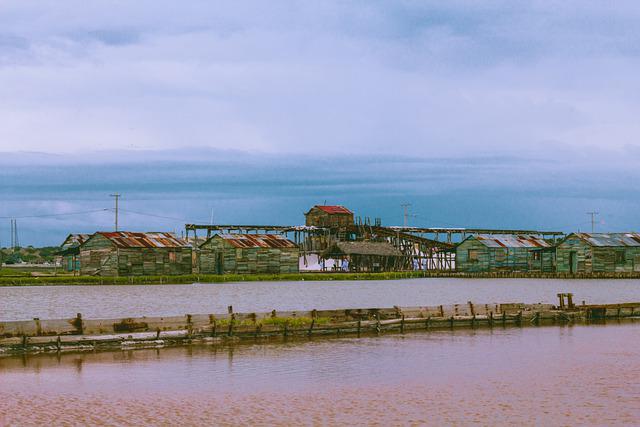Read time : 3 mins
Level : Advanced

By Dane Dickerson
A crack team of research engineers from the Massachusetts Institute of Technology (MIT) develops a user-friendly and portable unit that removes salt and other particles from ocean water in a flash. It is roughly the size of a suitcase and incredibly easy to use.
The portable desalinization unit was born in MIT’s Research Laboratory of Electronics (RLE), the birthplace of Ion Concentration Polarization (ICP) which is the filtration process behind its compact design.
For over a decade, a team of five, including senior author Jongyoon Han, sculpted a revolutionary desalination device into existence. It is primarily envisioned to help communities without clean drinking water create their own, among other applications.
The research study behind the unit was at last published in 2021 and approved in April of 2022. Han, a professor of electrical engineering and computer science, and biological engineering, reflects on the long journey in his interview with MIT press:
“This is really the culmination of a 10-year journey that I and my group have been on. We worked for years on the physics behind individual desalination processes, but pushing all those advances into a box, building a system, and demonstrating it in the ocean, that was a really meaningful and rewarding experience for me,” says Han.
Market Need
Portable and efficient desalination has massive potential in a world of unequal circumstances. It is estimated that 785 million people lack access to safe water (1/9th of the world’s population). Every 2 minutes, a child dies from a water-related disease, like diarrhea, giardiasis, dysentery, typhoid fever, E. Coli infection, and salmonellosis.
Many poor communities have access to saltwater without the means to purify it quickly. The ICP unit not only removes salt from water but all bacteria and harmful particulates. Anyone who has seen a couple of survival TV shows knows that saltwater rapidly dehydrates the body, and water-born illness can spell disaster for your insides.
Largescale desalinization plants have been around since the 1930s, but they simply aren’t an option for many poorer communities worldwide. Han’s portable unit could allow families to derive their water from oceans and streams without fear of disease or dehydration.
In the video presenting their device, Junghyo Yoon of ICP Water Tech (Han’s team) explains hopes for military application and disaster preparation.
“Needless to say, we are facing a water crisis due to climate change and our own human activity…To solve this problem, people have built seawater desalination plants. They are an excellent solution for people in urban areas because of the capital and infrastructure cities have to offer. However, what about people who live in places where desalination plants cannot be built? For example, very small groups who live on islands, remote workers in isolated areas, refugees facing natural disasters, or soldiers carrying out long-term military operations. All of these groups need a secure source of drinking water for basic survival,” says Yoon.
While the unit currently operates at the size of a carry-on bag, further development and downsizing could lead to applications in leisure activities for those inclined for the outdoors. For example, backpackers and campers could eliminate the need to carry excess water, and boating enthusiasts and anglers could have a new survival safeguard onboard.
How it Works
Typically portable desalination devices rely on filters and enormous high-pressure pumps to force water through microscopic holes that catch bacteria and minerals. As a result, they are much more challenging to design for portability and are impractical.
To solve this problem, ICP Water Tech’s unit functions upon Ion Concentration Polarization (ICP), a proprietary method created by Han’s researchers. The need for only a low-pressure pump allows the unit to desalinate and purify water using a small amount of electricity, less than a cellphone.
The ICP method creates an electrical field in membranes that surround the incoming flow of seawater into the device. These membranes repel any charged particles suspended in the water, in this case, bacteria, salt molecules, and viruses, funneling them into a discarded separate stream. The remaining water is primarily devoid of particles or living bacteria but may contain trace amounts of salt ions.
These are weeded out by a second process called electrodialysis. All of this is done within about 30 minutes, and the remaining water is safe to drink by World Health Organization standards.
In this video, Yoon, co-author and postdoctoral researcher on Han’s team, demonstrates how simple and effective their desalination unit is. Yoon tests the product in real-time at Boston’s Carson Beach. Watch as he throws the pump into the water, presses a button, and even drinks the resulting water a few minutes later. You’ll notice he uses a solar panel to power the device, which is not required.
The device developed at MIT is a prototype and produces drinking water at a rate of .3 liters per hour. They are working to make this process faster and even more energy-efficient, as plans for a startup company to market the device are underway.
Several institutions funded the study, including the DEVCOM Soldier Center, the Abdul Latif Jameel Water and Food Systems Lab (J-WAFS), the Experimental AI Postdoc Fellowship Program of Northeastern University, and the Roux AI Institute. The contributors listed in the study are corresponding authors Eric Brack and Jongyoon Han and authors Junghyo Yoon, Hyukin J. Kwon, and SungKy Kang.
